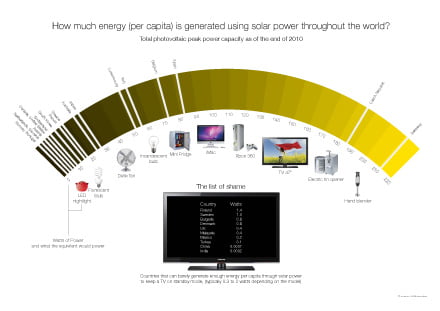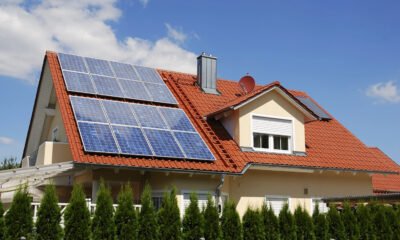

Features
Solar power progress
Using the vast energy of the sun is clearly on the rise, but what does it actually mean? Blue & Green Tomorrow looks at data from 2010 and represents it in a way we can all understand. Spreading the energy production from solar power over entire populations, we find that the UK is barely able to keep a TV on standby per person.
Germany and the Czech Republic are way out in front, producing enough solar energy to power a hand blender and an electric tin opener per capita, respectively. That might not sound like a lot, but try and imagine 82 million 210 watt hand blenders running 24/7 for 365 days — that’s a lot of smoothies.
Using the vast energy of the sun is clearly on the rise, but what does it actually mean? Blue & Green Tomorrow looks at data from 2010 and represents it in a way we can all understand. Spreading the energy production from solar power over entire populations, we find that the UK is barely able to keep a TV on standby per person.
Germany and the Czech Republic are way out in front, producing enough solar energy to power a hand blender and an electric tin opener per capita, respectively. That might not sound like a lot, but try and imagine 82 million 210 watt hand blenders running 24/7 for 365 days — that’s a lot of smoothies.
The Germans are the undisputed world leaders in solar power, generating six times more than the second highest producers, Spain, in 2011. And it’s on the rise: last year, its photovoltaic (PV) output surged by 60%.
 Click to enlarge.Moving further down the list, Spain just misses out being able to power an iMac, and instead has to settle with a mini fridge, along with fourth-placed Belgium.
Click to enlarge.Moving further down the list, Spain just misses out being able to power an iMac, and instead has to settle with a mini fridge, along with fourth-placed Belgium.
If you’re an Italian or a Luxembourgian, your solar output is at such a level that everyone can at least see the light by running an inefficient incandescent bulb, whilst countries like Norway, Portugal, Netherlands and Slovenia produce barely a twinkle — just enough energy to light an LED.
The list of shame — by which we mean countries that can barely generate enough energy per capita from solar power to keep a TV on standby (typically 0.3 to 2 watts) —includes some rather big names.
The UK, for example, produces just 0.4 watts of energy from solar power per capita. Meanwhile, arguably the world’s two fastest-growing economies, China and India, are way, way down the list, generating a measly 0.0007 and 0.0002 watts of solar power, respectively; despite an admirable showing from these two in terms of total energy generation from solar power, the sheer size of their populations drag them down.
The B> infographic hopefully highlights the need for a stronger global focus on solar power and perhaps helps us think about energy consumption more carefully. In fairness, the UK’s industry, in particular, is likely to have risen since these figures, because of the introduction of the feed-in tariff (FiT) scheme. Government cooperation is desperately needed, though, and appeals to cut subsidies for solar users are not the answer.
One major reason why Germany storms ahead in this sector is down to its successful FiT scheme, which sees inhabitants rewarded for renewable energy use. The UK should absolutely try and mimic the German model.
In the meantime, companies like Good Energy, the UK’s only 100% renewable electricity supplier, are going to great lengths to push up the country’s renewable contribution. Get in touch with them to convert your home to clean energy.
Infographics: Ben Willers
Related links:
Apple to install massive solar array































